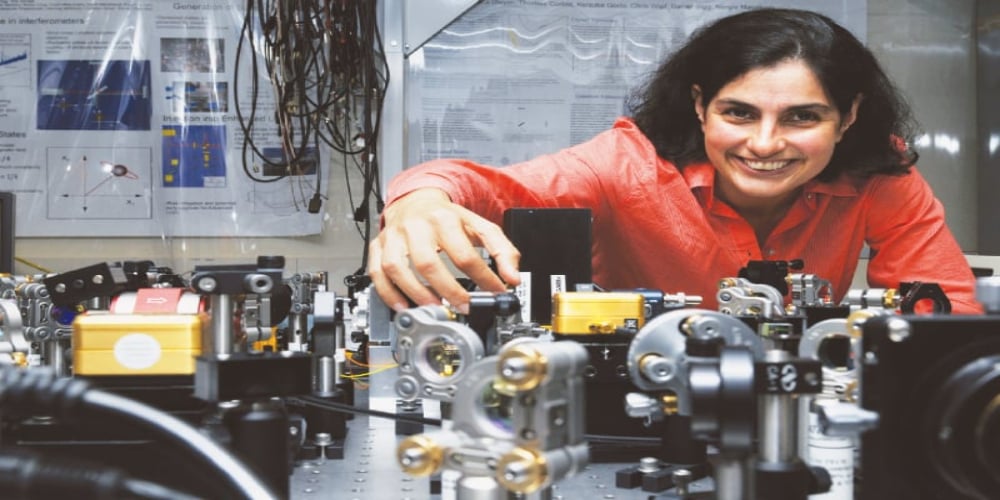
International Women’s Day 2020
The theme for International Women’s Day (8 March) 2020 is, I am Generation Equality: Realizing Women’s Rights.
International Women’s Day is a global day celebrating the social, economic, cultural and political achievements of women.
The theme aligns with UN Women’s new multi-generational campaign, Generation Equality, which marks the 25th anniversary of the Beijing Declaration and Platform for Action.
Moreover, the day also marks a call to action for accelerating gender parity.
International Women’s Day is a collective day of global celebration and a call for gender parity.
Gravitational Wave Researcher – Dr. Nergis Mavalvala
Ahead of International Women’s Day here we need to pay tribute to the Pakistan born scientist Dr. Nergis Mavalvala, who discovered gravitational waves made by the Laser Interferometer Gravitational-Wave Observatory (LIGO).

Dr. Nergis Mavalvala – Biography:
Professor Nergis Mavalvala received a B.A. from Wellesley College and a Ph.D. from MIT.
She was a postdoctoral fellow and research scientist at the California Institute of Technology before joining the Physics faculty at MIT in 2002.
In 2017, Mavalvala was elected to the National Academy of Sciences.
During her graduation at the Massachusetts Institute of Technology (MIT) she started working on gravitational waves – which would lead her to one of the biggest discoveries of the century.

Born and Family:
Dr Mavalvala, was born to a Parsi family in Karachi where she did her primary schooling.
Among the scientists is Dr. Nergis Mavalvala, who was migrated to the United States of America as a teenager.
She completed her doctorate in Physics from the MIT, where she is currently the Curtis and Kathleen Marble Professor of Astrophysics, and Associate Department Head of Physics.

Practical Skills:
Her practical skills stood her in good stead in 1991, when she was scouting for a research group to join after her first year as a graduate student at MIT.
Her adviser was moving to Chicago and Mavalvala had decided not to follow him, so she needed a new adviser.
Furthermore, she met Rainer Weiss, who worked down the hallway.
“What do you know?” Weiss asked her. She began to list the classes she had taken at the institute—but the renowned experimentalist interrupted with, “What do you know how to do?” Mavalvala ticked off her practical skills and accomplishments: machining, electronic circuitry, building a laser.
However, Weiss took her on right away.
Mavalvala says that although it may not be immediately apparent, she is a product of good mentoring.

MIT:
Her work on gravitational waves was part of her research in graduate school at MIT, where she now is an associate department head of Physics.
She credits her success to a host of mentors who’ve helped her get to where she is now with a special mention going out to the chemistry teacher in Pakistan who let her play with reagents in the lab after school.

Dr. Nergis Mavalvala – LIGO:
Before MIT, she was a postdoctoral associate and then a research scientist at California Institute of Technology (Caltech).
Moreover, she worked on the Laser Interferometric Gravitational Wave Observatory (LIGO).
She has been involved with LIGO since her early years in graduate school at MIT and her primary research has been in instrument development for interferometric gravitational-wave detectors.
Award & Achievement:
Dr. Nergis Mavalvala also received the prestigious MacArthur Foundation Award in 2010.

Experiments:
In the quest for ever greater sensitivity in the LIGO detectors, Mavalvala has also conducted pioneering experiments on generation and application of squeezed states of light, and on laser cooling and trapping of macroscopic objects to enable observation of quantum phenomena in human-scale systems.

Selected Publications:
- Measurement of radiation-pressure-induced optomechanical dynamics in a suspended Fabry-Perot cavity,” T. Corbitt, D. Ottaway, E. Innerhofer, J. Pelc, and N. Mavalvala, Phys. Rev. A 74, 021802 (2006).
- A squeezed state source using radiation pressure induced rigidity,” T. Corbitt, Y. Chen, F. Khalili, D. Ottaway, S. Vyatchanin, S. Whitcomb, and N. Mavalvala, Phys. Rev. A 73, 023801 (2006).
- Lock acquisition of a gravitational wave interferometer,” M. Evans, N. Mavalvala, P. Fritschel, R. Bork, B. Bhawal, R. Gustafson, W. Kells, M. Landry, D. Sigg, R. Weiss, S. Whitcomb, H. Yamamoto, accepted for publication in Opt. Lett. (2002).
- Readout and control of a power-recycled gravitational-wave antenna,” P. Fritschel, R. Bork, G. González, N. Mavalvala, D. Ouimette, H. Rong, D. Sigg, and M. Zucker, Appl. Opt. 40, 4988 (2001).

Read More News On
- Dr Nergis Mavalvala
- Dr Nergis Mavalvala biography
- Dr Nergis Mavalvala experiments
- Dr Nergis Mavalvala LIGO
- Dr Nergis Mavalvala MIT
- Dr Nergis Mavalvala Pakistani scientist
- Dr Nergis Mavalvala research
- International Women's Day
- International Women's Day 2020
- International Women's Day 8th March
- International Women's Day Sunday
- Nergis Mavalvala gravitational waves
Catch all the International News, Trending News, Breaking News Event and Latest News Updates on The BOL News
Download The BOL News App to get the Daily News Update & Follow us on Google News.



